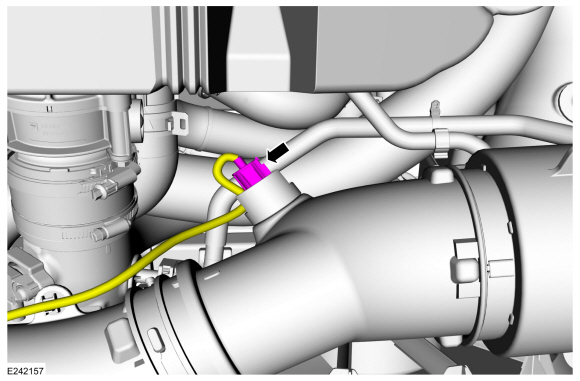Lincoln Navigator: Electronic Engine Controls - 3.5L EcoBoost (272kW/370PS) / Intake Air Temperature (IAT) Sensor. Removal and Installation
Lincoln Navigator 2018-2025 Workshop Manual / Engine / Electronic Engine Controls - 3.5L EcoBoost (272kW/370PS) / Intake Air Temperature (IAT) Sensor. Removal and Installation
Removal
NOTE: Removal steps in this procedure may contain installation details.
-
Disconnect the IAT sensor electrical connector.
 |
-
Remove the IAT sensor.
 |
Installation
-
To install, reverse the removal procedure.
 Knock Sensor (KS). Removal and Installation
Knock Sensor (KS). Removal and Installation
Removal
NOTE:
Removal steps in this procedure may contain installation details.
Remove the direct injection fuel rail LH and RH side...
Other information:
Lincoln Navigator 2018-2025 Workshop Manual: Steering Wheel and Column Electrical Components. Diagnosis and Testing
Diagnostic Trouble Code (DTC) Chart Diagnostics in this manual assume a certain skill level and knowledge of Ford-specific diagnostic practices. REFER to: Diagnostic Methods (100-00 General Information, Description and Operation). Module DTC Description Action BCM B108A:01 Start Button: General Electrical Failure GO to Pinpoint Test A BCM B108A:24 Start..
Lincoln Navigator 2018-2025 Workshop Manual: Liftgate Release Switch. Removal and Installation
Removal Remove the reversing lamp assembly. Refer to: Reversing Lamp (417-01 Exterior Lighting, Removal and Installation). Disconnect the coaxial cable connector. Remove the screws and the bracket. Remove the rear housing. Disconnect the electrical c..
Categories
- Manuals Home
- 4th Gen Lincoln Navigator Service Manual (2018 - 2025)
- Remote Function Actuator (RFA) Module. Removal and Installation
- Body Control Module (BCM). Removal and Installation
- Power Running Board (PRB). Diagnosis and Testing
- Body and Paint
- Identification Codes. Description and Operation
Wheel to Hub Runout Minimization. General Procedures
Check
NOTE: Wheel-to-hub optimization is important. Clearance between the wheel and hub can be used to offset or neutralize the Road Force® or run-out of the wheel and tire assembly. For every 0.001 inch of wheel-to-hub clearance, the Road Force® can be affected between 1 and 3 pounds depending on the tire stiffness.
NOTE: The example below illustrates how the clearance between the wheel and the hub can be used to offset the high spot of radial run-out or Road Force®. Following the procedure will make sure of the best optimization.
Position the wheel and tire assembly on the vehicle so that the high spot location of radial run-out or Road Force® is at the 6 o'clock position andCopyright © 2025 www.linavigator4.com

